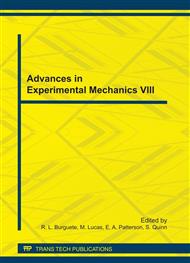p.99
p.105
p.111
p.117
p.123
p.129
p.135
p.141
p.147
Using Digital Image Correlation Techniques and Finite Element Models for Strain-Field Analysis of a Welded Aluminium Structure
Abstract:
The use of aluminium in lightweight structures and corrosive environments is continuously increasing. Welding is often used to assemble different aluminium components and it is of great importance to take into account the deteriorating effect the welding operation on the aluminium’s strength when designing these structures. In the present study, the strain-fields of welded aluminium tensile specimens have been analysed by digital image correlation (DIC) techniques, micro hardness measurements and finite element (FE) modelling. The stress-strain curve of the weld material, the heat affected zone (HAZ) and the base material have been determined by tensile tests. The material properties and the extension of the HAZ were also correlated to the micro hardness. The experimental data has been used as an input to the material models of the FE analysis. The study shows that using FE-analysis in combination with strain-field determination by DIC is very powerful. The resulting strain-fields are easily compared and the FE-analysis is verified in a straightforward way. Furthermore, the results of the study suggest that micro hardness measurements could be used to derive the strength of the material affected by the welding operation.
Info:
Periodical:
Pages:
123-128
Citation:
Online since:
August 2011
Authors:
Price:
Сopyright:
© 2011 Trans Tech Publications Ltd. All Rights Reserved
Share:
Citation:


